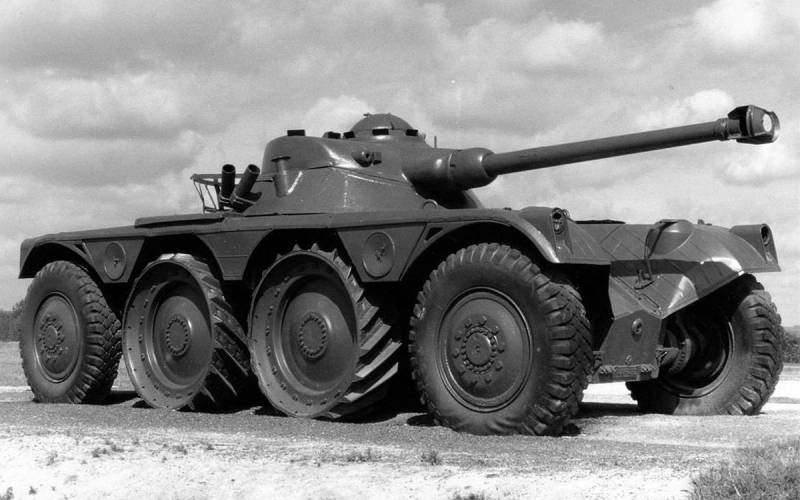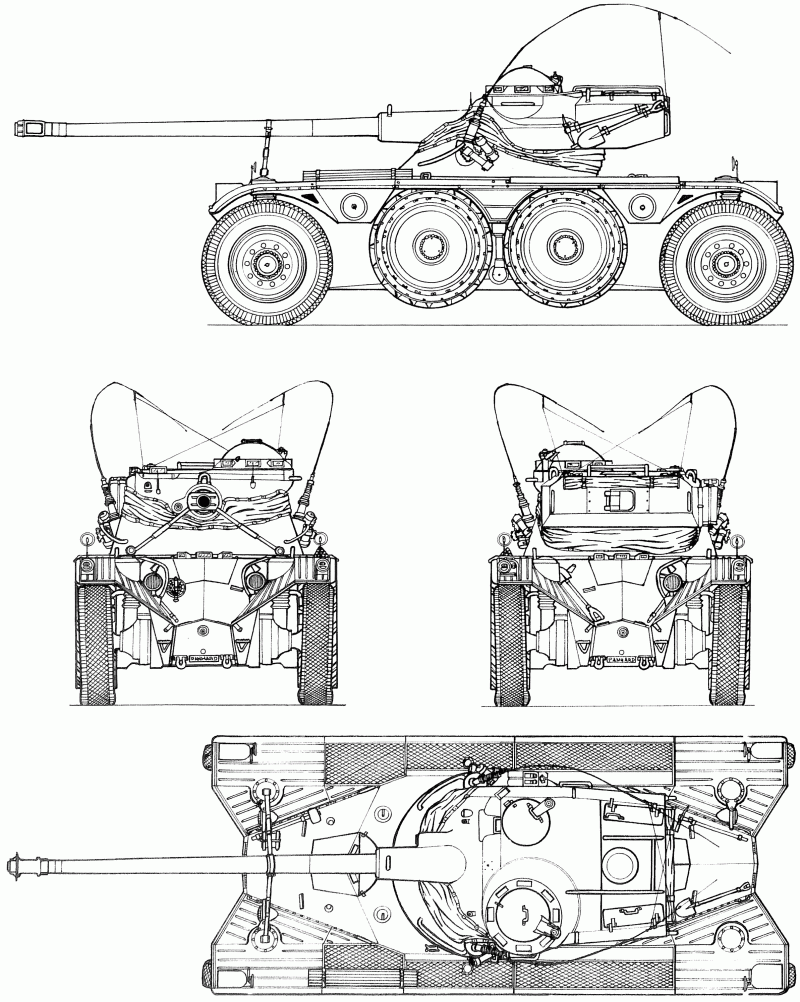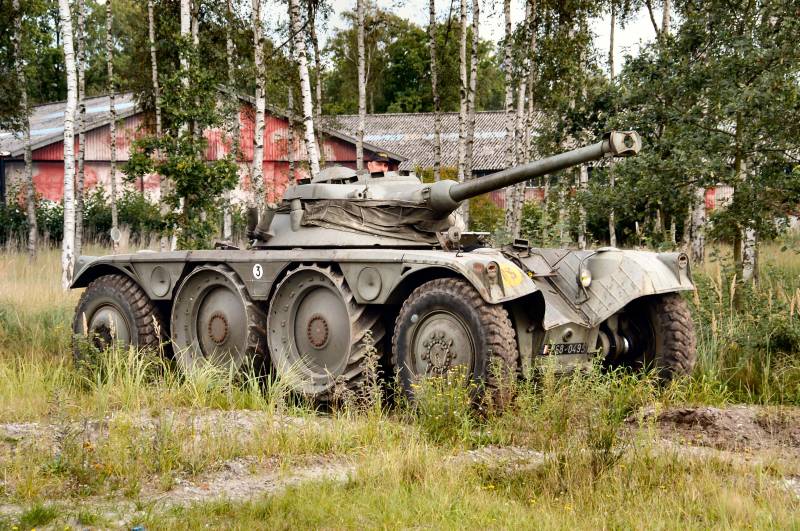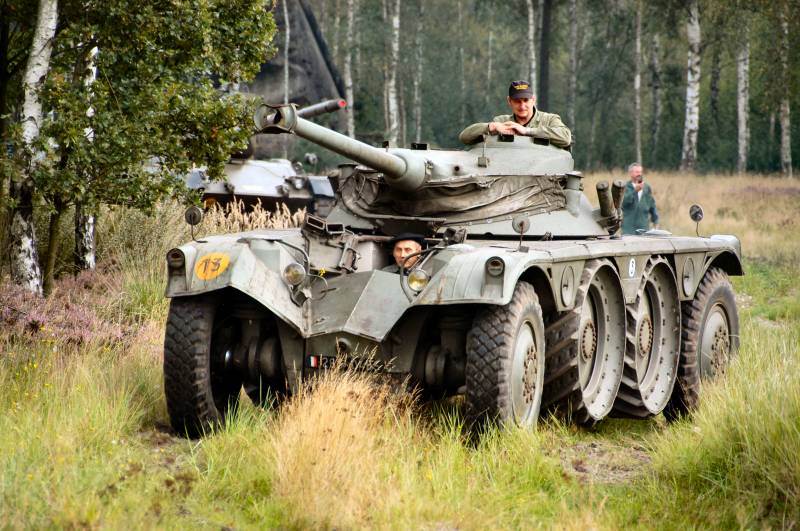Armored reconnaissance vehicle Panhard EBR
Among the most successful pre-war developments of French engineers include all-wheel drive cannon armored car. Panhard 178. Following him, the designers of one of the oldest automobile companies in France "Panhard" created an even more sophisticated armored car. Improved armored vehicle received the designation Panhard 201, there was also the designation of the prototype Panhard AM 40Р. It was built in a single copy, the Second World War prevented the further development of the project, although 1 of May 1940 was received from the military ministry for the construction of 600 of such armored vehicles. The only armored car built in June 1940 was taken to Morocco, where it disappeared without a trace. This did not prevent the revival of the design of an armored car with the wheel formula 8х8 in the first post-war years, and finally, in an updated version, the armored car was brought to the stage of mass production.
An improved version of the armored car under the designation Panhard EBR (Engin Blindé de Reconnaissance - armored reconnaissance vehicle) was fully ready for the beginning of the 50-s of the last century. The Panhard EBR cannon armored car was mass-produced in France from 1951 to 1960 a year. It was an all-wheel drive four-wheel wheeled armored vehicle with a total weight of more than 13 tons. The swinging turrets with 75-mm or 90-mm guns (armored car models with different guns were designated respectively Panhard EBR 75 and Panhard EBR 90) could be installed on it, so the auxiliary armament was three 7,5-mm machine guns. However, non-weaponry was the main feature of this combat vehicle. Of greatest interest was the chassis, which included two medium lifting bridges with all-metal wheels (when lifting medium bridges, the wheel formula was changed to 4 x4). Another feature of the armored car was the presence of two control posts and, accordingly, the possibility of an equivalent movement forward and backward.
Work on a new wheeled armored car with cannon armament began in France in September 1949. The basis was taken Panhard 201 armored car, but it was not a blind copy of the pre-war fighting vehicle. Various changes were made to the design, which occurred to the chief designer Louis Delyagardt during the war years. He made a new armored car longer and wider, and the front and rear of the hull became completely identical (this step had a positive effect on the cost of production).
The frontal armor plates of the welded hull were located at a double angle, forming a three-pitch shape, such a design was known as the “pike nose”. This nose was completed with a “jaw” 40 mm thick. Due to its small size, this part could only protect the legs of the driver, but it had another purpose - it was used as a strength element of the structure, tying together parts of the body of the armored vehicle. A characteristic feature of the armored case was that it was symmetrical in terms of not only relative to the longitudinal, but also relative to the transverse axis. In both wedge-shaped parts of the hull, the front and rear had its own control post with a driver's seat. Thanks to this feature, the armored car could easily get out of the shelling, without turning. Moreover, the features of the transmission allowed the cannon armored car to move backward at the same speed with which it could move forward.
The body of the armored car was welded. Its frontal and stern sheets were installed with significant tilt angles, the side plates were installed vertically. In the frontal and aft parts of the armored hull were rectangular hatches used by driver mechanics. The crew of a cannon armored car Panhard EBR consisted of four people: the commander, gunner and two driver-mechanics.
The engine was moved to the center of the hull and located directly under the tower. Since not every engine could be placed in such a limited space, the designers designed the six-liter 12-cylinder horizontal-opposed engine Panhard 12H 6000S (block height was only 228 mm) especially for the Panhard EBR armored car. This gasoline engine developed the maximum power of the 200 HP. at 3700 rpm When it was created, the cylinder-piston group and the block from the two-stroke two-cylinder engine of the small-car Panhard Dyna were taken as the basis. Through a compact multi-plate clutch, torque from the engine arrived at the gearbox 4F4Rx4. It would be more accurate to say that these were two checkpoints at once, which were combined into a single node according to a non-coaxial scheme. In this case, the second box simultaneously served as a blocking inter-sided differential, and a transfer case with a reverse mechanism for changing the direction of movement of the armored vehicle.
The onboard transmission system has its advantages. It is good because it does not allow the wheels to slip on one side, which very well affects the patency of the car. In this scheme, it is possible to do with one differential, while the efficiency of the onboard transmission is not very high due to the presence of numerous angular gears and a very large number of gear pairs. For example, in the Panhard EBR French armored car, the direction of torque changes the first time to 90 degrees on the output shaft of the first gearbox, the second time when torque is distributed along the shafts that go along the hull sides to the front and rear wheels and again directly to drive wheels The static ground clearance of the Panhard EBR cannon armored car was 406 mm (a very decent figure, at the level of a Unimog truck). In order to improve the management of armored vehicles in turns, the designers placed on the shafts leading to the front wheels, a freewheel clutch.
The armored car received a chassis with 8 wheels: the front and rear pairs are ordinary with tires and pneumatic chambers, but the two middle pairs of wheels were metal with well-developed notched lugs. With the 8X8 scheme implemented, the Panhard EBR armored car moved along the highway, relying only on the wheels of the external axles. The aluminum wheels of the internal axles were lowered only when off-road. They increased the machine’s permeability and reduced ground pressure (up to 0,7 kg / cm2). Used lever mechanism with a hydropneumatic drive and served as the elastic element of the suspension of the middle axes of an armored car. The wheels of the front and rear pairs were suspended on concentric springs.
For the first time, a new armored car was shown in public during a parade on the Champs Elysees in Paris, which took place on July 14 of the year 1950. The parade was dedicated to the Independence Day of France. Panhard EBR became the first wheeled armored vehicle of its own design, which entered service in the post-war period. In the midst of a serious conflict with the massive use of armored vehicles, this armored reconnaissance vehicle was extremely vulnerable. The thickness of the sides did not exceed 20 mm, the hull and tower foreheads - 40 mm. However, the French General Staff saw a niche for this car - it was the Theater d'Operation d'Outre-Mer (overseas theater of military operations), the armored vehicle was intended for colonial wars with a poorly prepared and poorly armed opponent.
For this role, a fast armored car with powerful cannon armament was the best fit. Very often partisan detachments tried to compensate for the apparent lack of weapons with the speed and surprise of the attacks. The determining factor for the fight against them became speed, maneuverability and range. Panhard EBR fully possessed all these qualities. Its maximum speed on the highway was 105 km / h, range - about 630 km. With a combat weight of about 13,5 tons, the armored car spent only 55 liters of fuel per 100 km (when driving on roads, in order to prevent yaw, the steering gear of the rear wheels was blocked by the armored car). At the same time, it might seem that the armored car so large in size was slow (the length of the hull was 5,54 m, the total was 6,15 m), but this was not true. Thanks to the presence of four steered wheels, its turning radius was only 6 meters. And thanks to the impressive wheelbase, the armored car could nonstop on the move to overcome trenches up to two meters long. Here he did not concede and tanks.
The main armament of an armored car was located in a swinging turret. We can say that she was no less remarkable than his transmission. The French engineers, without hesitation, decided to install on the Panhard EBR armored cars part the FL10 turret from the light AMX-13 tank with the 75-mm cannon and the 7,5-mm machine gun paired with it (two more machine guns were located in the body). This solution has greatly facilitated the supply of ammunition and maintenance of the machine in the conditions of military operation.
The use of a rocking tower was a feature of this combat vehicle. The swinging tower consisted of two parts: the bottom, which was connected with the tower support and the top, which was placed on the bottom on the trunnions so that it could rotate relative to the last vertical plane at a certain angle. In this case, the gun was rigidly connected with the upper swinging part of the tower. The tool was guided vertically by turning the upper part of the turret, and horizontal guidance by rotating the lower part. The use of this design facilitated the installation of the automatic loader, allowing to reduce the size of the tower. In the upper swinging part of the FL10 turret, two turret-type drums were installed on 6 shells each. This mechanism allowed to bring the rate of fire to 12 shots per minute. However, he had one significant drawback, which he got from a tank tower and an armored car. It was possible to reload the drums only manually, for this purpose one of the crew members had to leave the combat vehicle, which was, to put it mildly, unsafe under the conditions of the battle. Ideally, for reloading the drums, the combat vehicle had to go out of combat.
The use of such a mechanism of semi-automatic charging allowed to exclude the loader from the crew. The commander was sitting on the left, the gunner on the right side of the tower. Each of them had their own hatch. The commander’s hatch on the left side of the tower had a dome-shaped cover that was folded back. At the base of the hatch was installed 7 prism surveillance devices that provide the commander with a circular view. The FL11 turret, which was more actively placed on Panhard EBR armored cars, did not have a feed niche and, consequently, an automatic loader. It was first installed 75-mm gun SA49 c shorter barrel length, and then low-pulse 90-mm gun. The crew of such a machine also consisted of a 4 man, instead of the gunner a loader was added, in this case the commander himself performed the duties of the gunner.
On the armored car Panhard EBR put two versions of swinging towers. The EBR 75 FL 11 version was distinguished by the installation of a “11 type” tower with the 75-mm SA 49 gun. The armored car with the FL 11 turret was released 836. The other model had a “type 10” turret with an 75-mm SA 50 gun installed in it, the model name EBR 75 FL 10, such as 279 was released. In 1963, X-NUMX-mm cannon CN-11F90 was installed in the FL 90 tower. This model of armored car received the designation EBR 2 F90. At the same time, ammunition reduced to 2 shells instead of 44 in 56-mm variants, however 75-mm feathered cumulative projectile, which provided armor penetration up to 90 mm, appeared in it, which made it possible to effectively use it to fight all tanks of that time period.
On the basis of the Panhard EBR cannon armored car in France, the EBR ETT armored personnel carrier and the sanitary armored car were also produced. In total, from 1951 to 1960 year, about 1200 armored vehicles of this type were assembled. For many years they became the main armored vehicles in the French army, and were also actively exported: to Morocco, Portugal, Tunisia, Indonesia, Mauritania. The largest military conflict with their participation was the war for the independence of Algeria, which lasted from 1954 to 1962 years. They were also used in the Portuguese Colonial War (a whole series of conflicts) from 1961 to 1974 year and in the War in Western Sahara (1975-1991). Under the conditions of African heat and high dustiness, the Panhard EBR design proved to be very good, the reconnaissance armored car was famous for its unpretentiousness and reliability. Otherwise, the crew and technical experts would curse everything, since in order to repair the engine from an armored car, it was necessary to first dismantle the turret.
It is interesting that the Panhard EBR wheeled armored car, from which the tower was dismantled, was used as a hearse at the funeral ceremony of the French President, General Charles de Gaulle.
Performance characteristics of Panhard EBR 75 (FL 11 tower):
Overall dimensions: length - 6,15 m, width - 2,42 m, height - 2,24 m.
Combat weight - about 13,5 tons.
Reservations - from 10 to 40 mm.
The power plant is a XHUMX-cylinder carburetor engine Panhard 12H 12 horsepower 6000.
Maximum speed - 105 km / h (on the highway).
Power reserve - 630 km.
Armament - 75-mm gun SA 49 and 3 machine gun caliber 7,5-mm.
Ammunition - 56 shots and 2200 ammo
Wheel formula - 8x8.
Crew - 4 person.
Information sources:
http://www.off-road-drive.ru/archive/20/Simvol_Pyatoy_respubliki
http://zonwar.ru/bronetexnika/sovr_BTR/Panhard_EBR.html
http://warspot.ru/9664-panar-pushechnyy-tyani-tolkay
Open source materials





Information